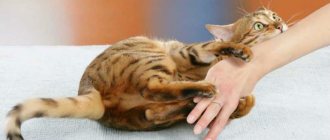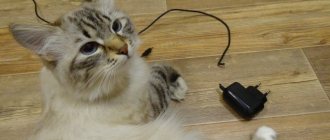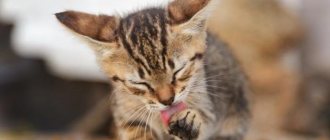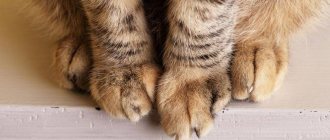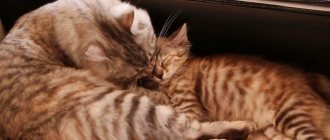If a cat has kittens for the first time, then her behavior may alert the owner: she begins to bite her cubs. The reasons for a strange habit can be different - natural behavior or the result of a disease. The article discusses the natural behavior of cats.
Biting as a method of education
Nature has not given a cat much time to feed and raise its offspring.
As a rule, after 2 - 3 months the female is again ready for fertilization and gestation. Therefore, in a short period of time, the mother must raise and teach her cubs the laws of survival in harsh reality. At the same time, the learning process involves not only biting the baby; those who are especially slow-witted can get hit with a paw. The cat is trying to instill in the young the rules of good manners, how it is possible and how it should not behave in a given environment. At the time of upbringing, the mother can persistently, but without causing injury or leaving marks, bite the child until it understands what is required of it. Taking care of her offspring, the mother closely monitors that all the kittens are in her field of vision, in the best case - in the nest. And if a particularly nimble and restless baby constantly tries to leave the house, tries to crawl away or run away, the cat applies appropriate educational measures to him, bites him and demands obedience.
Quite often, the mother herself accustoms her babies to the tray. And if the kitten does not understand what is required of him and refuses to go to the toilet in a specially designated place, the pet, as a rule, takes strict measures to raise the careless cub.
A mother cat may bite her kittens when she is tired, wants to rest, and naughty children are too annoying and disturb her.
Not only the mother, but also the father can teach the baby to be smart. The reasons why a cat bites a kitten on the neck are often related to the educational process and the establishment of authority. This happens if the father lives in the same room with his offspring, or when a kitten comes into the house where an adult male lives.
What not to do in the process of education
A person can stop a kitten from scratching and biting only if he does not make common mistakes:
- You can't hit a kitten. You need to reprimand him in a stern voice and leave him alone for a while. The pet will understand that biting and scratching its owner's arms and legs is unacceptable. And physical violence will embitter the animal even more.
- Prohibitions must be observed by all family members. If the owner is trying to wean the animal from scratching and biting, and the relatives allow the baby to behave this way, you should not expect success.
- You can't provoke a kitten. It is forbidden to deliberately tease a baby and then punish him for biting and scratching. The animal will become completely confused.
- You should not play with a kitten without special devices. Toys that exclude direct contact will help to wean a kitten from biting and scratching during play: laser pointers, wind-up mice, bows on strings. You cannot use your own hands and feet. Otherwise, the baby will get used to scratching and biting.
- You cannot limit your pet's movement. For proper development, the baby must run, jump, and imitate hunting. The lack of such an opportunity and being forced to stay within four walls cause behavioral anomalies.
To wean a kitten from scratching and biting, you need to establish the reason that caused such actions. After this, you can begin raising your child before the wrong behavior becomes a habit.
The reason lies in the disease
Biting kittens is not always an educational moment or a manifestation of natural instinct. If the animal is exhausted after childbirth, weakened, it is difficult for him to control his behavior. In this case, the cubs are perceived negatively by the mother, and she may even try to get rid of them. The bites in this case are aggressive in nature.
Often the reason why a cat bites newborn kittens is a serious illness of the mother - postpartum eclampsia or milk fever. The disease occurs due to the development of calcium deficiency in the body. A low level of the mineral leads to inadequate mental behavior of the animal, provokes aggression and convulsions. The cat's coordination of movement is impaired and drooling is observed. Body temperature rises to 410 C.
During attacks, the mother may exhibit uncontrollable aggression towards her offspring. This condition requires urgent veterinary care, as the animal may die from depression of the respiratory center or cardiac arrest.
We recommend reading the article on how to distinguish a cat from a cat. From it you will learn about the correct determination of sex in a newborn kitten, appearance at one month of age, sex differences in habits and the main physiological differences of animals.
Other reasons
In addition to natural instincts and the educational process, there are other explanations why a cat bites its kittens:
- In order to stimulate their physical activity. Young animals must quickly build muscle mass, and for this, kids must move actively.
- The cat is unhappy with the nest, it is too hot, or it is located in a noisy place.
- The onset of heat. In this case, the female is aggressive towards the offspring and can bite her cubs.
- Foreign odors from kittens. Babies should not be touched with hands, as cats communicate using their sense of smell, and other people's smells can cause inappropriate behavior in the mother.
- Genetic abnormalities or hidden pathologies in kittens. Cats instinctively sense disturbances in the development of their young and can, by biting, check the viability of the offspring or try to get rid of them.
There are many reasons why a cat bites her kittens - from the manifestation of natural instincts to a serious illness. The owner of the animal must observe and control the behavior of his pet. If educational techniques are playful and do not cause harm or injury, then such behavior should not cause concern. In case of aggression or injuries, it is better to consult a veterinarian. The kittens may have to be separated from their mother earlier than planned.
What can I do to stop kittens constantly quarreling?
As kittens grow older, they begin to behave like adult cats. Often the causes of conflicts between kittens are related to control of their food and environment. Often these are territorial conflicts.
In this case, be sure to give them their own territory before attempting to separate them. To do this, if possible, avoid having all kittens use the same bowl or litter box.
- Place several pillows, litter trays, and feeders in different places in the house so that each kitten has its own territory.
- Set up several scratching posts or cat trees.
- Leave lots of toys for kittens to distract them .
Parenting with bites
We use the carrot and stick method when raising our children. A cat does the same thing. But nature gave her much less time for feeding and raising her offspring. Usually after 2-3 months the mother will be ready to bear kittens again, and in such a short period of time she must teach the cubs to survive in the harsh world. Therefore, the cat sometimes uses not only biting kittens, but also hits them with her paw. In this way, the mother tries to instill in the children the rules of conduct, teaches how not to behave. At such moments, she can bite the kitten without causing injury until he understands what is required of him. The cat always makes sure that all children are in her field of vision, in the nest and do not try to leave it. And when her most nimble and curious child shows disobedience, she forces him to obey. Sometimes the mother accustoms her cubs to the tray. And in this case, she also bites them and does not allow them to leave until they do the wet job.
Biting as an educational measure occurs when the cat gets tired, wants to sleep, and children climb on it like on a playground. She calms annoying and nimble children in this way. By the way, if dad lives next to his mother cat, then he can raise his offspring in the same way. This is how daddy cat demonstrates his authority and dominance.
There are always various dangers awaiting kittens on the street. Therefore, the mother is obliged to teach them to fight back the enemy. Even if the cat is domesticated and does not encounter serious predators, at the genetic level the mother is trying to teach her offspring self-defense skills. When she bites children on the neck, she shows them the most vulnerable place in a fight with an opponent - this is how she teaches them to avoid attacks from strangers.
Typically, cat self-defense lessons are played in a playful way. The mother bites the cubs lightly, pinching their skin. The skills acquired from her help the young to survive, defend themselves, their territory, and fight back against the offender.
Hunting instincts
Cats by nature are hunters. They have well developed hunting instincts. A mother can teach her cubs the wisdom of hunting when they are already grown up. She bites them, demonstrating how to capture and hold prey. Sometimes you can see how the mother cat grabs the baby with her front paws, beats him with her hind paws and bites him on the neck. So she teaches him basic hunting skills.
After such lessons, children can hone their skills on each other. And all this happens under the control of the mother. When they play too much, the cat intervenes and bites their neck, letting them know that it’s time to stop.
Protection from dangers
Instincts dictate to cats that there are enemies in nature. Although in the modern living conditions of cats there are not many enemies, the kitten must be prepared to protect itself from them. A mother cat helps with learning. The most unprotected place on an animal is the scruff of the neck. This is where the cat most often bites her kittens, at the same time showing that you should avoid a bite from an enemy on the neck, but try to bite here yourself.
Lessons are usually held in the form of a game, the bites from the mother are weak. A little later, the kittens begin to practice the learned techniques on each other, diligently biting each other with sharp teeth. Here the bites are already real, sometimes either the owner or the mother cat has to intervene to separate the fighters. After such a school, an adult animal is able to protect itself from offenders, defend its authority in the cat environment, and conquer new territories of residence.
Raising offspring
The role of the mother is not only to give birth and feed the child, but also to raise her. Mother cat is no exception. A cat can raise kittens with words (purring, meowing and hissing) and physical force: biting the kittens or giving in with its paw. The animal does not know any other way. Most often, cats bite their babies: this is the most effective method in nature.
While the babies are very small, the mother cat tries to hide her offspring from prying eyes. In case of unauthorized crawling out of the “nest”, the kitten may receive an educational bite. As a rule, the cat bites the kitten on the scruff of the neck, but does not leave any marks on the skin. A kitten’s squeak is not a cry of pain and a call for help, but an answer to its mother: “I won’t do it again!” After such a bite, the mother cat diligently licks the baby.
Grown-up kittens already receive permission to move freely around the territory of their residence and happily explore the new world. How can you do this without games? Kittens play with each other and with toys. Particularly playful youngsters strive to play with their mother’s tail. And immediately they receive an instructive bite in response or a blow with a paw. The cat teaches her kitten to stay within the bounds of decency and respect older, stronger fellow tribesmen.
Some cats teach their kittens to be clean and teach them to go to a certain place intended for natural needs. One tray in a house with kittens will not be enough. And naughty or slow-witted kittens receive punishment from their mother, again in the form of bites.
Why does a kitten bite and scratch?
A kitten may bite and scratch for several reasons. Having understood them, the owner will be able to correct the pet’s behavior and wean it from a bad habit.
Gambling passion
Cats are predatory animals. They have a hunting instinct since childhood. When kittens begin to walk on their own, they fuss with each other, try to fight and attack. This is the preparatory stage.
From about the fifth week, the mother cat begins to teach the babies how to hunt. For example, she brings a caught mouse so that the kittens can hone attack and defense techniques, and by her example shows how to hunt.
As a result, the play and hunting instincts are mixed. When the baby sees a moving object - both a toy and the owner's limb - he rushes at it and bites it. He has no intention of hurting a person. The pet simply develops the makings of a predator.
For your information. Even adult cats succumb to the excitement of the game.
Some owners themselves encourage aggression. They think that a baby attacking a person's big hand looks very funny. Indeed, at 1.5-2 months the animal does not pose a threat.
However, when the pet grows up, it will behave in exactly the same way. A big cat can leave deep scratches and bite through the skin. To wean the kitten from biting and lunging at people, it is provided with a variety of toys. With their help, he will be able to imitate hunting. Then he will not need to encroach on human hands and feet.
Kitten feeling unwell
If your pet is constantly biting and scratching for no reason, he may be sick. This is how animals replace their suffering.
In addition to aggressive behavior, the disease is indicated by:
- vomit;
- diarrhea;
- apathy;
- refusal to eat;
- increased or decreased body temperature;
- sneezing and coughing;
- unpleasant odor from the mouth.
In this case, you do not need to wean the animal from bad habits, but contact a veterinarian. After recovery, the baby’s behavior returns to normal.
Important. Kittens may pretend to be sick to manipulate their owner. Such attempts must be stopped.
Biting may be a symptom of changing teeth. At 3-4 months, the kitten’s baby teeth begin to fall out, and permanent teeth grow in their place.
Associated symptoms:
- increased salivation;
- loss of appetite;
- head shaking;
- slight increase in temperature.
The teething process is often accompanied by itching and discomfort. To alleviate the condition, the baby tries to “scratch” his gums: chew things, furniture, wires, people’s arms and legs.
The only way to help your pet is to relieve him of pain. Chewable treats, toys, and silicone teething rings will help stop your kitten from biting. Attempts to taste the owner's body must be stopped. Otherwise it will develop into a bad habit.
Behavioral reasons
Kittens that are separated from their mother early grow up to be more aggressive. They have not gone through initial socialization and have not had time to build trusting relationships with people, so they are suspicious of them.
In this case, the pet may scratch or bite the person in self-defense. The kitten does not understand the owner’s intentions, which is why it prefers to immediately defend itself.
Correcting this behavior is very difficult. To wean a kitten from biting and scratching, you need to handle it as carefully as possible and not expose it to stress. The baby should not fear for his life. Then the need for defense will disappear by itself.
It is better to keep your distance for some time. Let the kitten watch the owners from the side. He will understand that family members do not pose any threat. Most likely, your pet will gradually learn to trust people, and you will no longer have to wean him from unwanted habits.
Scratching and biting are common in kittens that have not been introduced to the outside world. Ideally, the pet should have access to all rooms, see strangers, smell new smells and hear interesting sounds. Then the kitten will not be afraid if guests come to the house and the owner suddenly turns on the vacuum cleaner. He won't see this as a threat, so he won't bite or scratch in self-defense.
Sometimes kittens try to attract attention with aggressive behavior. Animals bite or scratch when they want to eat, drink or go to the toilet, and the litter box is not cleaned. Therefore, the owner must carefully care for the baby. Then the pet will not have to resort to such methods.
For your information. Usually a cat bites people's legs if it needs attention.
Another reason why a kitten bites its owner or owner on the legs is boredom. He cannot realize the innate instinct of a hunter, so he is forced to attack any available prey.
If the baby does not have toys, human limbs are the most suitable option. Only active and varied entertainment will help wean a kitten from a bad habit.
Animals may scratch and bite if they lack personal space. The baby should have his own corner where he can be alone and relax. You should not install the bed where it is convenient for the owner. Cats independently choose their favorite places.
Some breeds avoid body contact. This cat bites when you pet it or pick it up. Therefore, before weaning your child from a bad habit, you should take a closer look at the characteristics of his character.
Often, owners themselves provoke aggression when:
- petting the kitten too roughly (for example, against the grain);
- they grab it tightly during the game;
- they try to pat the stomach - the most vulnerable place.
If this is the reason, you need to reconsider your own behavior. And you won’t have to stop the kitten from scratching and biting.
Hunting training
Another reason for kitten biting: hunting training. In this case, the cat pinches the kitten with its front paws and hits it with its hind paws. At the same time, the cat will bite its “prey”, managing to lick the bitten places. Practicing catch-and-hold hunting techniques is carried out both in pairs with a mother cat and with litter brothers and sisters. Later, elements of waiting in ambush, sudden jumps from cover, and pursuit will be added.
The mother cat first demonstrates all the hunting tricks to her children herself, and then happily participates in the pursuit of toy mice along with her kittens. Trained hunters will never be left without prey: all candy wrappers will be mercilessly caught. If a domestic cat has the right to go outside, then a real mouse or small bird can become prey.
All considered examples of biting are elements of education, rules of behavior in cat society, training in protection and hunting. If a cat does not harm her kittens and does not show increased aggressiveness towards them, then the owner has no reason to worry: she acts on the basis of her natural instincts.
How do you know if two cats get along?
Cat-cat relationships are similar to relationships with other people; that is: there are those who we like the first time, others who will never like us for various reasons, and others who once you get to know you gain confidence. We behave differently with each of them, as I said, depending on the degree of self-confidence.
If we talk about felines, we will see that they act more with a friendly cat than with an unknown cat. How then do you know if they get along or not? Okay, If they trust each other, we will see that:
- They are playing
- They look after each other
- Spend time together
- Their fights are good vibes, meaning play without grunting or hard biting.
- If one accidentally hurts the other (for example, a kitten to an adult cat), the other only needs to growl a little to leave him alone.
A cat bites its kittens - reasons
Cat instincts oblige you to educate your offspring from infancy. Often, owners can observe that the pet begins to drag the children by the scruff of the neck, hit them with their paws, and even bite them. And this behavior raises concerns about why a cat bites its kittens. What is considered normal, and what serves as an alarm bell?
Kittens grow quickly and therefore the mother cat has little time left to instill in her offspring all the basic life skills. If this is not so urgently necessary for domestic animals, then for street animals it is a matter of survival.
© shutterstock
There is no need to worry if the cat bites and thereby does not injure the kittens; this is only a method to rein in a naughty baby. As a result, he squeaks and makes it clear that he understands.
What does a cat teach its offspring?
- Hunt. This instinct remains from the times when in nature cats had to get food. Therefore, the cat teaches the art of survival, which can help in conquering its territory. During training, she can bite a kitten, showing how to properly suppress the victim. Then they themselves will practice this on each other. The cat will teach the grown kittens to attack prey from a hiding place.
- Protect from danger or stop the game.
Until a certain point, the cat does not let the kittens out of a secluded place where they are safe. Therefore, all attempts to leave him can be stopped by a bite on the scruff of the neck. She often bites the kitten in order to grab it and drag it to another place. The cat may bite the baby several times to choose the correct and safe point, and then carefully pick it up and carry it away. The pet also bites angry kids who are too carried away by the game. By analogy with a person, this is a slap to a fidget. - Toilet train. Some especially clean furry mothers can pass on to their kittens the ability to relieve themselves in a certain place. This happens already at the stage when the young animals are old enough to understand what is wanted from them. And those who refuse to learn are sometimes bitten or hit by the cat with its paw.
© shutterstock
When should you be concerned if your cat bites your kittens?
Sometimes bites become a sign of a cat's aggression towards its offspring. It is easy to recognize if you watch the progress of learning or playing. Usually the mother bites, but controls her actions, takes care of the babies, even after biting, she licks them. But not all cats behave this way. Stress caused by childbirth or personality traits can influence aggressive behavior. Then she bites the kittens, leaving marks, hisses, and can hit them hard with her paw.
The second common factor in the development of hostility towards kittens can be a disease called eclampsia, pain in the mammary glands caused by feline mastopathy, or simple fatigue. It is not recommended to make a diagnosis yourself; entrust this to a veterinarian. He will prescribe the correct treatment that will benefit the pet and its offspring.
Let us dwell in more detail on such an unpleasant disease for a cat when she bites her kittens, such as eclampsia. It occurs due to calcium leaching and can appear 2-3 weeks after birth. The disease can be recognized by the behavior and appearance of the pet. Signs will include the following symptoms:
- lethargy or increased excitability,
- pronounced signs of aggression towards the owner and offspring, the cat may bite kittens, leave and be absent for a long time,
- mucous membranes turn pale, breathing becomes rapid,
- Limb spasms and convulsions may occur,
- There is profuse salivation, increased body temperature, and trembling.
Eclampsia, called milk fever, is a dangerous disease for cats. Therefore, you need to notice the symptoms as early as possible and consult a doctor. An increase in body temperature to extreme levels and respiratory depression as a consequence of an attack can cause the death of the animal.
© shutterstock
An acute attack of eclampsia should be an alarming signal to urgently call a veterinarian. The owner and the doctor may have too little time to provide assistance and save the cat’s life.
Cat bites to test health conditions to identify weak kittens
Noticing how a pet bites its children, you can remember the law of nature that says that the fittest survives. Often a cat bites kittens not only for educational purposes, but also to identify children with congenital pathologies. Animals are aggressive towards such individuals.
The survival instinct does not allow the cat to leave the sick kitten; she will probably abandon him. She identifies sick individuals by biting each one and looking at the reaction. Be careful if any kitten is left without attention or if you notice obvious aggression towards it on the part of the mother. She will probably want to get rid of the patient. Show him to the veterinarian, perhaps all is not lost and after treatment the cat will accept the baby again.
How to distinguish a sick kitten from a healthy one
Take each kitten in your arms and carefully examine it; it is quite easy to distinguish an unhealthy one. Healthy kitten:
- plump, with a round belly,
- the skin is pink in color, easily smoothed out if folded and released,
- warm and stretches out on the palm.
© shutterstock
Sick baby:
- very lethargic and can barely move or, on the contrary, is too active, but does not have enough energy for long and collapses from fatigue,
- skin is bluish, cool,
- constantly squeaks pitifully.
The kittens may all be healthy, but the cat aggressively bites one or more. Perhaps she has little milk and this is a way to feed at least part of the offspring. Then caring for the younger generation should fall on the owner. All that remains is to feed the babies with milk from a pipette or syringe without a needle.
You don't always need to sound the alarm when cats bite. If they do not harm the kittens, then this may just be a learning phase. Serious behavioral abnormalities require observation and consultation with a veterinarian. Aggression when she bites kittens is unacceptable. Show more attention if the cat has become a mother for the first time, help her survive stress, and she will become caring and attentive to her babies.
IMPORTANT! VETERINARIAN CONSULTATION REQUIRED. INFORMATION FOR INFORMATION ONLY. Share with friends Article rating
Eclampsia in a cat: what are the signs and what to do?
Eclampsia (aka milk fever) is provoked by hypocalcemia - a disorder of calcium metabolism in the body, in which it begins to be sorely lacking. Milk fever usually develops in the first 2–3 weeks after lambing. This is due to the active leaching of calcium from the blood, due to the fact that it is involved in the formation of milk. Most common in mothers with multiple births.
3:1989
Behavioral signals of developing eclampsia:
- Increased excitability and anxiety or lethargy and complete apathy;
- Aggression accompanied by lack of recognition of offspring and owners;
- Refusal to sit with own kittens;
- Avoidance of droppings feeding and biting, leaving marks on their skins;
- Frequently moving babies from place to place.
Physical signs of milk fever:
- Pointed muzzle with stretched skin and exposed fangs;
- Rapid breathing;
- Pale mucous membranes;
- Movements become abrupt;
- The animal has difficulty rearranging its “stiff” hind legs due to muscle spasms;
- Convulsions (intensity depends on the severity of the disease);
- Increased body temperature;
- Shiver;
- The pet often falls on its side;
- Uncontrollable salivation appears.
In a cat with eclampsia, the temperature rises to +41 °C. Carbon dioxide accumulates in the body, making it difficult for the animal to breathe. The pH in the blood increases and the calcium level decreases.
3:1787
Milk fever is not so much dangerous for others as it is for a sick pet. If help is not provided in time, death from hyperthermia - due to depressed breathing and brain damage - will occur 12 hours after the onset of the attack.
3:426
If your pet has an acute attack of eclampsia, call your veterinarian immediately. Sometimes time passes by minutes, especially when an attack is not detected immediately, the doctor may simply not have time. It is in this case that, while waiting for the doctor, you will need to provide first aid to your pet yourself.
3:972
In case of an acute attack of eclampsia, it is necessary to inject subcutaneously:
- Fospasim or any other sedative - 1 ml;
- Gamavit - 1 ml;
- Calcium borgluconate (heated to 39°) - 2-3 ml at intervals of 45 minutes until symptoms disappear;
- No-shpa - 0.3 ml;
- Prednisolone - 0.5 ml.
After injections, place the cat in a dark, noise-free room until the attack stops. To prevent relapse, calcium (1 ml) will need to be injected 2 times a day for about two more weeks.
3:1833
As the disease progresses, the kittens are taken from the mother cat and fed with an artificial formula, then returned. If the babies are more than 3 weeks old, introduce complementary foods; formula alone will no longer be enough for them.
3:372
Certain cats are more prone to milk fever than others. If your pet is predisposed to eclampsia - if such an attack has occurred at least once - it is necessary to pay special attention to her after lambing. In addition, it is worth worrying about the issue of prevention in advance by consulting with a veterinarian. As a rule, a diet with a high calcium content is prescribed. Cats at risk always have a fairly high chance of relapse. For such pets, the intervals between lambings should be as long as possible.
3:1389
4:1893


